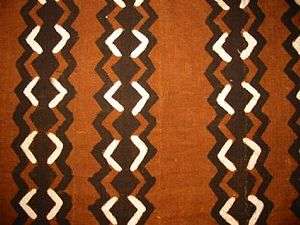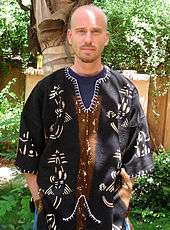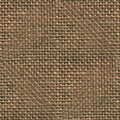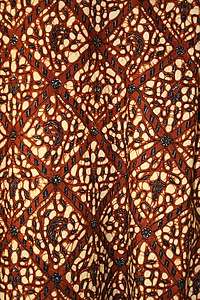Bògòlanfini
Bògòlanfini or bogolan (Bambara: bɔgɔlanfini; "mud cloth") is a handmade Malian cotton fabric traditionally dyed with fermented mud.[1] It has an important place in traditional Malian culture and has, more recently, become a symbol of Malian cultural identity. The cloth is exported worldwide for use in fashion, fine art and decoration.

Origins and etymology
The dye technique is associated with several Malian ethnic groups, but the Bambaran version has become best known outside Mali. In the Bambara language, the word bògòlanfini is a composite of bɔgɔ, meaning "earth" or "mud"; lan, meaning "with" or "by means of"; and fini, meaning "cloth".[1] Although usually translated as "mud cloth," bogolan actually refers to a clay slip with a high iron content that produces a black pigment when applied to handspun and handwoven cotton textiles.[2]
Production
The center of bògòlanfini production, and the source of the highest quality cloth, is the town of San.[3]
Traditional production
In traditional bògòlanfini production, men weave the cloth and women dye it. On narrow looms, strips of cotton fabric about 15 centimetres (5.9 in) wide are woven and stitched into cloths about 1 metre (3 ft) wide and 1.5 metres (5 ft) long.[1]
The dyeing (a "strange and cumbersome technique", according to the 1973 opinion of J.B. Donne[4]) begins with a step invisible in the finished product: the cloth is soaked in a dye bath made from leaves of the n'gallama (Anogeissus leiocarpa) tree that have been mashed and boiled, or soaked. Now yellow, the cloth is sun-dried and then painted with designs using a piece of metal or wood. The paint, carefully and repeatedly applied to outline the intricate motifs, is a special mud, collected from riverbeds and fermented for up to a year in a clay jar. Because of a chemical reaction between the mud and the dyed cloth, the brown color remains after the mud is washed off. Finally, the yellow n'gallama dye is removed from the unpainted parts of the cloth by applying soap or bleach, rendering the finished cloth white.[1]
After long use, the very dark brown color turns a variety of rich tones of brown, while the unpainted underside of the fabric retains a pale russet color.[4]
Variants and modern production
Around Mopti and Djenné, a simpler method is used by artists considered to be of inferior skill.[3] The cloth is dyed yellow in wolo solution, made from the leaves of Terminalia avicennoides, and then painted over with black designs. The yellow is either removed, producing a stark black and white design, or painted a deep orange with a solution from the bark of M'Peku (Lannea velutina).[3]
Based on these simplified techniques, as of around 2000, large quantities of bògòlanfini are being mass-produced for the tourist and export markets. These fabrics use simpler designs, often applied by stencil, painted in black on a yellow or orange background. With this method, the cloth can be produced about six to seven times faster. The democratic reforms after the overthrow of Moussa Traoré in 1991 caused many young men to lose their previously guaranteed government jobs and scholarships. This led many to take up bògòlanfini production. Consequently, most cloth is now produced by men rather than women, and the traditional year-long apprenticeships have been replaced by short, informal training sessions.[3]
Cultural significance
In traditional Malian culture, bògòlanfini is worn by hunters and serves as camouflage, ritual protection and a badge of status. Women are wrapped in bògòlanfini after their initiation into adulthood (which includes genital cutting) and immediately after childbirth, as the cloth is believed to have the power to absorb the dangerous forces released under such circumstances.[1]
Bògòlanfini patterns are rich in cultural significance, referring to historical events (such as a famous battle between a Malian warrior and the French), crocodiles (significant in Bambara mythology) or other objects, mythological concepts or proverbs.[1] Since about 1980, Bògòlanfini has become a symbol of Malian cultural identity and is being promoted as such by the Malian government.[1]
Uses
Bògòlanfini has become a popular Malian export, notably to the United States. There, it is marketed as "mud cloth", either as a symbol of African American culture or as a generically "ethnic" decorative cloth.[1]
In fashion

In Mali, the cloth is worn by people of all ethnicities, including prominently in Malian cinema and by Malian musicians, either as an expression of national or ethnic identity or as a fashion statement. Particularly popular among young people, bògòlanfini is made into a wide range of clothes, including Western miniskirts and jackets as well as traditional flowing robes (boubous).[1]
The Malian fashion designer Chris Seydou has been credited with popularizing bògòlanfini in international fashion.[1]
In art
Bògòlanfini is also produced as fine art by several Malian artists, notably by the Groupe Bogolan Kasobané, six artists collaborating since 1978. These paintings are produced with vegetable dyes and mud, but often feature designs unrelated to those of traditional fabrics; their newer motifs are also often found on clothing.[3] Other notable creators include Nakunte Diarra.[5]
Traditional bògòlanfini designs are also used for on a wide range of commercial products, such as coffee mugs, curtains, towels, sheets, book covers and wrapping paper.[3]
References
- Rovine 2005.
- Goldner 2008, pp. 58–59.
- Toerien 2003.
- Donne 1973.
- "Collections - National Museum of African Art". africa.si.edu. Retrieved 18 September 2018.
Bibliography
- Donne, J.B. (1973). "Bogolanfini: A Mud-Painted Cloth from Mali". Man. 8 (1). JSTOR 2800615.CS1 maint: ref=harv (link)
- Goldner, Janet (2008). The Poetics of Cloth. Grey Art Gallery, New York University. ISBN 978-0-615-22083-3.CS1 maint: ref=harv (link)
- Rovine, Victoria L. (2005). "Bogolan". In Steele, Valerie (ed.). Encyclopedia of Clothing and Fashion. 1. Thomson Gale. pp. 169–170. ISBN 0-684-31394-4.CS1 maint: ref=harv (link)
- Toerien, Elsje S. (2003). "Mud cloth from Mali: its making and use". Journal of Family Ecology and Consumer Sciences. 31: 52–57. ISSN 0378-5254.CS1 maint: ref=harv (link)
Further reading
- Brett-Smith, Sarah (2014). The Silence of the Women: Bamana Mud Cloths. ISBN 9788874396702.
- Hilu, Sam; Hersey, Irwin (2005). Bogolanfini Mud Cloth. Atglen, PA: Schiffer Publishing Ltd. ISBN 978-0-7643-2187-0.
- Imperato, Pascal James; Shamir, Marli (Summer 1970). "Bokolanfini: Mud Cloth of the Bamana of Mali". African Arts. 3 (4): 32–41, 80. doi:10.2307/3345905.
- Rovine, Victoria (Winter 1997). "Bogolanfini in Bamako: The Biography of a Malian Textile". African Arts. 30 (1): 40–51, 94–96. JSTOR 3337471.
External links
| Wikimedia Commons has media related to Bogolan. |
- "Discovering Mudcloth". National Museum of Natural History.
- Enderle, Melissa. "Bogolan Cloth: images of the production process". Archived from the original on 5 October 2009.
- Hager, Liz (1 March 2010). "Malian Bogolanfini and Cultural Identity". Venetian Red.


.svg.png)